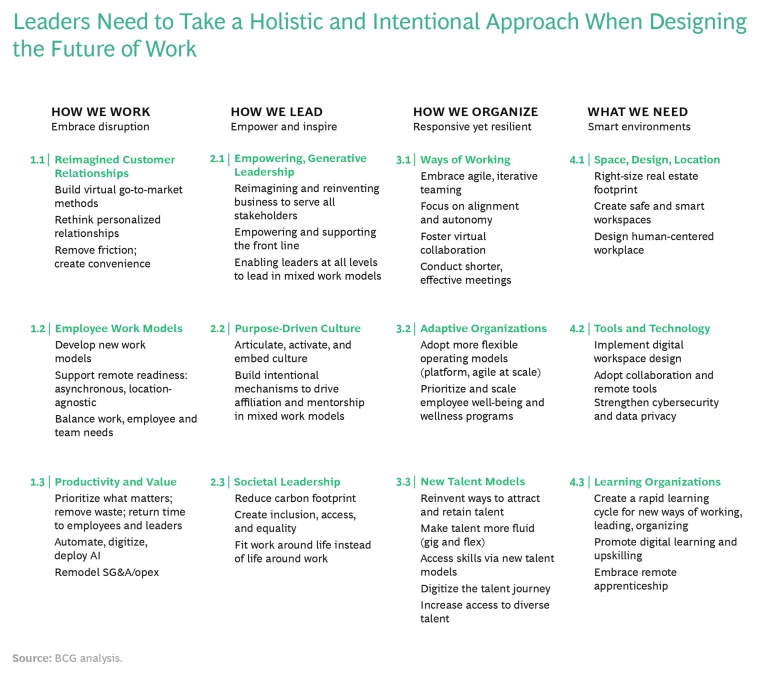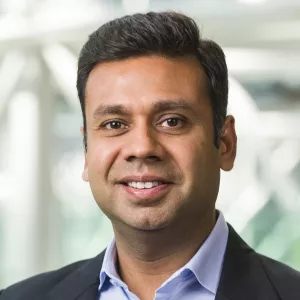The pandemic has caused unprecedented organizational disruption. But it also has offered valuable lessons about the way we work—and created significant opportunities.
This article was first released in November 2020 and has been updated.
The best leadership teams have spent the past two years leaning into the changes COVID-19 has brought to their organizations. As a result, their companies will have a definitive customer, innovation, employee, and productivity advantage for years to come. Other companies—those that are not rapidly locking in and extending how they serve customers and communities and support their people—will lose.
Amid this evolving competitive landscape, BCG has developed an integrated approach that enables organizations to quickly and systematically create advantage. When it comes to the future of work, there is no one-size-fits-all model. Instead, leaders and their teams need to design their own modus operandi intentionally, holistically, and thoughtfully. We recommend examining four critical areas: how we work, how we lead, how we organize, and what we need. (See the exhibit.)
How We Work
Embracing, rather than trying to recover from, the organizational disruption caused by the pandemic will provide a rich source of new and improved work practices. This means reassessing customer needs, adopting innovative work models, and finding new ways of unlocking productivity.
Reimagined Customer Relationships. Companies exist because of their customers, and any discussion of the future of work must begin there—especially as customers’ needs have dramatically evolved. Leaders should ask themselves three questions up front:
- What do our customers need, both today and in the near future?
- How do our customers want to engage with us?
- What pandemic-driven innovations have truly pleased our customers, and how can we take them further?
Globally—across both the B2B and B2C sectors—customers have rapidly shifted away from in-person interactions and toward digital ones. Many of these adaptations will endure, and customers will come to expect a truly integrated digital and physical experience, with interactions that begin online and continue in person or vice versa. Smart companies will look back on the constraints COVID-19 put on relationships and commerce as a source of innovation. Early in the pandemic, one retail executive told us that “COVID has been our chief innovation officer.” Indeed, for companies with an opportunity-focused mindset, possibilities abound.
Employee Work Models. No one (hopefully) believes in returning to the past, when work happened primarily with colleagues who adhered to fixed hours and locations whether it was necessary or not. Nor is the opposite extreme, where work is entirely remote and/or occurs at unpredictable times, a viable long-term strategy. People still want—and sometimes need—to meet physically, with predictable hours, to collaborate, cocreate, and congregate.
We recommend four steps to create more differentiated work models:
- Align on the business outcomes and guardrails for future work models. The CEO and executive team need to agree on what they are solving for (what mix of employee satisfaction, productivity, or cost reduction, for example) and the associated guardrails (such as maintaining flexibility, creating meaningful time together, and ensuring a level playing field for all talent).
- Determine the range of work models based on the work and the people. What are the archetypes and personas? What “deskless” jobs—in manufacturing, hospitality, retail, or health care, for example—need to be done in person but can offer flexible shift timing and/or allow for shift exchanges when personal needs arise? What “desk-based” jobs can be done by bringing a laptop home but still need time for teams to come together to ensure collaboration and creativity—and with what frequency should those teams meet in person? Which of our people are more comfortable, engaged, and productive in flexible models? For example, we know from our research as a founding partner of the Future Forum that, among desk-based workers in the US, Asian, Hispanic, and Black employees are somewhat more likely to want flexibility in their jobs than white employees; globally, more women say they want flexibility than do men. So flexible work models can also help address goals related to diversity, equity, inclusion, and belonging.
- Provide teams with the knowledge, skills, and tools to develop their working norms. Teams will need to establish their own cadence for working in person and apart, and they will need to agree to specific norms around communication, work planning, collaboration, and learning. For example, adopting a “one person on screen, everyone on screen” rule—in other words, asking those who are attending a meeting in person to join virtually on their laptops so that those working remotely can see their individual faces and not feel disadvantaged—will maintain the level playing field created by the pandemic. Teams will also need tools that enable hybrid scheduling and optimize space utilization. And teams need weekly time to reflect on and evolve their working norms.
- Build the learning ecosystem. It is important to recognize that these new ways of working represent significant change—and that we all need to put in the effort to develop the right capabilities and skills to thrive in these new work models. Best practices, once established, need to be disseminated quickly and teams need to be upskilled rapidly. Companies should integrate AI-enabled skill and acumen assessment, always-on and applied learning, and individualized learning journeys to thrive in this new environment.
Productivity and Value. Finally, the company needs to gauge whether its new models are succeeding. Do they sustain morale, creativity, and productivity?
These elements are notoriously hard to measure. In operational and industrial work, a strong correlation exists between inputs and outputs; carefully controlling the inputs generally ensures the quality and efficiency of the outputs. But in many jobs, correlating outcomes to inputs is far more difficult. For example, people are not necessarily more productive just because they are exchanging more emails and attending more meetings. A focus on impact rather than presence, inputs, and strictly quantitative outputs will better enable productivity, as will fostering strong alignment and clear, cascading objectives for co-located and remote teams alike.
The other impact COVID-19 had was to immediately highlight the slow, paper- and human-based processes that could not easily be made remote. Technologies like AI, automation, and robotics are no longer potential long-term investments but much more immediate priorities.
How We Lead
Most of today’s leadership models were designed decades or even centuries ago, when managers and supervisors watched over subordinates who performed narrowly defined, repetitive work. Over the past 30 years, these models have seen incremental improvement. But now the world needs leaders to truly transform: to become more generative, to promote a purpose-driven culture, and to ensure their organizations are helping drive progress on larger societal issues.
Empowering, Generative Leadership. “Generative,” as we use it, means that leaders need to work as teams across locations and time to meet the needs of their people, their customers, their communities, and the planet while delivering profit for shareholders. Leaders should be laser focused on ensuring that every person and thing an organization engages with is left better off as a result of that interaction—for example, investing to grow people’s skills through new opportunities, such as training factory workers on automation and robotics.
This is even more challenging for leaders within the new work models. Building cohesion in teams and coaching new skills can be harder across location and time. Similarly, integrating new employees and building trust takes more intentionality. It is critical to build the capabilities of all managers to coach, mentor, inspire, motivate, and develop distributed teams. At the same time, organizations need to ensure they are fairly assessing the contributions and performance of those who are working more remotely compared to those who are more regularly in the office—especially given the research noted above regarding the preferences of diverse talent.
Purpose-Driven Culture. Humans are social creatures who need to connect in some form with others and to do so with a purpose. Companies must strive to identify their unique purpose—the need in the world that they uniquely fill. And then they must use that purpose every day: to adjust strategic priorities, inform how leaders lead, guide day-to-day interactions, and create culture. A strong purpose has been proven to be a key differentiator in both the commercial and talent marketplaces.
Culture, contrary to belief, does not require physical presence to build. Culture is built when decisions are being made; when ideas and knowledge are communicated; when people are hired, celebrated, and given responsibility; and in the rhythms and routines that are the heartbeat of the organization. In other words, we have been creating culture every day since the pandemic hit. Every leader needs to be mindful and intentional about how their actions create culture, regardless of location.
Societal Leadership. We also have become acutely aware of every organization’s responsibility to take care of more than just their shareholders and their people. Every organization must think about how they can help with issues of climate, racial equity, income inequality, and other important societal priorities for the long term—and preferably as part of their core business and operations and not perfunctorily off to the side.
How We Organize
To lock in the changes outlined above, operating models will need to be rewired; roles, processes, organizational structure, and talent models will need to be transformed. Otherwise, organizations will be pulled back into old ways of working.
Ways of Working. Something valuable happened to work in the early days of the pandemic, even amid the tragedy of COVID-19. Low-value work disappeared; people forgot what their “day job” was; we came together across siloes, and even across companies, to work together on the most important priorities to keep our employees, customers, and businesses secure. We moved retail workers to call centers, claims processors from vision and dental to health care, and even shifted workers across companies to ensure supply chain integrity.
What was the impact of all this cross-silo, cross-functional, cross-company, priority-driven teaming? A lot of good: we focused on what mattered with speed, quality, and efficiency, supported by high frequency experimentation and iteration that occurred daily and weekly instead of quarterly or yearly. In other words, organizations all became more agile. The challenge now is to make this the way we always work and not fall back into the old, sluggish, risk-averse, hierarchical ways. How do we do that?
Adaptive Organizations. Moving to agile-at-scale and platform organization models will allow these streamlined, efficient, and cross-functional innovations to become more enduring. This means recasting the entire operating model and reinventing the structure, roles, processes, people, culture, and technology to reinforce—and not get in the way of—how we want and need to work.
The pandemic also saw organizations step up in how they take care of people. In countries without adequate childcare, companies came forward with on-site day care centers in a matter of weeks or offered stipends to cover the cost of care. New mental health resources and supports were put in place and telemedicine and virtual medical care was made available as needed. One executive shared with us that they “no longer hire employees, they hire families.” Another said, “We take care of our people 24/7, not just when they are working.” This is what it now means to belong to an organization—and it will need to stick.
New Talent Models. The “great resignation” also presents a great opportunity, particularly when employees are looking beyond their immediate geographic location for the work opportunity that best fits their needs and desires. Companies that embrace location-agnostic hiring and work policies will benefit from higher quality and more diverse candidates. Teams that set a cadence of “together and apart” that reflects location-agnostic work policies may find themselves “at the office” for a few weeks week a quarter, making the office more like a conference center—replacing “offsites” with “on sites.”
Similarly, companies should invite discussions about alternative labor models, including leveraging the gig economy for shorter-term projects. The film industry has employed this model for decades: studios rarely employ artists, actors, and musicians permanently. Instead, they assemble a crew with the right skills to complete a specific project.
This gig model of deployment can also be done for full-time employees. Again, this is what we saw at the beginning of the pandemic, when it was “all hands on deck” and people moved across organizations to help regardless of their official jobs. There are multiple tech platforms that can help enable this kind of talent fluidity within organizations, and AI-based skills tracking can make it easier to identify opportunities for contribution that may not have been apparent before.
What We Need
To enable these new ways of working, leading, and organizing, companies will need to transform their physical workplaces, invest in new tools and technology, and upskill all their people.
Space, Design, Location. Not surprisingly, the pandemic has revealed opportunities to rethink the workplace. The question, at this point in history, is why offices exist at all? What purpose do they serve? In a postpandemic work world, we believe they exist for connection, collaboration, affiliation, and learning. If these are the four functions of the office, then the ability of an office to deliver those functional outcomes becomes the criteria for evaluating success. Behavioral science has long proven that casual encounters deliver business value, so we need the company café and other social spaces for connection. We need spaces that allow teams to co-locate and collaborate and team zones that include support for work that occurs both together and apart. We need spaces, objects, signage, and even colors that help employees understand their purpose together and that help them affiliate. We need spaces and setups that promote learning together, mentoring, and growth. What we don’t need is rows of individually assigned desks.
Tools and Technology. Shared desk- and space-booking tools are essential to making this work. When a team or individual books a space or desk, that information can be shared so that others can plan their visits to coincide. That booking also provides data on utilization, allowing the office itself to learn from how it is being used and providing valuable insights to the facilities team. Booking can also drive demand prediction for everything from cooling to coffee. Companies need to take an intentional approach, ensuring that the booking systems, sensors, and feedback loops encourage unplanned social “collisions,” empower on-site collaboration, build affiliation and loyalty, and create opportunities for learning.
Companies also need to ensure the right remote tools exist, as well as the skills to use them. Teams need transparency into work progress and prioritization through a shared “to do” list. They need an online whiteboard. They need hybrid scheduling that provides awareness of who will be where and when. As teams flex between connecting remotely and in person, digital tools will make interaction seamless across space and time.
Learning Organizations. The concept of a learning organization was coined by Peter Senge over 30 years ago. But to date, learning has remained mostly off to the side with formal training and development. This is not how people learn. To truly build new muscles, learning must be completely embedded in the flow of daily work, making every moment a learning moment. This means leaders and managers need to ask questions, observe, and coach daily. Teams need to create space at the end of every meeting and every week to reflect on one or two things that worked well and one or two things that could have been improved for the next interaction. Rotating talent, enabled by new flexible talent models, will also drive opportunities for daily learning.
But a complete reskilling will be required to turn existing talent into digital talent. This reskilling requires more intensive and immersive formal learning, with immediate application and practice in real work environments, done side by side with experts. Our experience with organizations has shown a robust six-month digital reskilling program can completely reskill workers to perform well in digital roles. For example, BCG cybersecurity experts have reskilled existing talent to fill cyber positions; in fact, they estimate 85% of open cyber roles can be filled this way.
Follow These Five Lessons
Now is the time for all companies to actively mine the lessons learned amid the organizational disruption of the pandemic. Now is the time to:
- Recognize that the shift toward flexibility is here to stay. Many customer and employee behaviors that took root during the pandemic will become permanent.
- Be holistic to create competitive advantage. The future of work is not about letting desked workers work from home two to three days a week; smart companies embrace business model changes in all parts of their organizations for all of their employees.
- Start with the customer. When designing new work models, companies should think like their customers and anticipate how their needs and preferences will change the work.
- Elevate the employee. Companies need to purposely create culture and connection. They should build all employees’ capabilities to thrive today and in future work models, and they should balance the needs of the organization, teams, and employees. And they should actively engage employees in cocreating the future together.
- Act and be adaptive. Companies that delay will find that their competitors have not stood still. Be explicit about testing new ways of working, assessing what works, and being ready to adapt. The key is to embrace experimentation and then scale the successful experiments.
The COVID-19 crisis has generated a wave of human ingenuity and productivity. The future of work has arrived. We are optimistic and pragmatic about the potential for companies, individuals, and society. It’s now up to each company to shape it. Or get shaped by it.
The authors of the 2020 version of this article were Bharat Khandelwal, Debbie Lovich, Joppe Bijlsma, Frank Breitling, and Penny Metchev. We want to acknowledge their foundational work on this topic, which has enabled this next phase of innovation and insight, and to thank our many clients and colleagues who have also contributed to our collective understanding of what the future of work could be.















